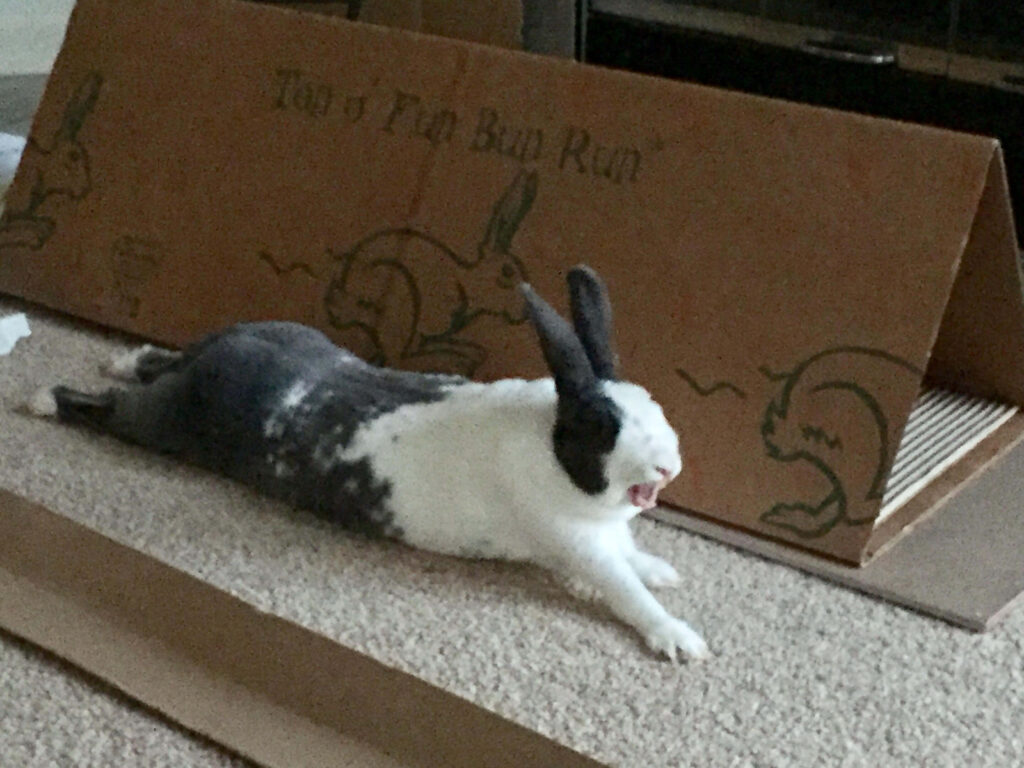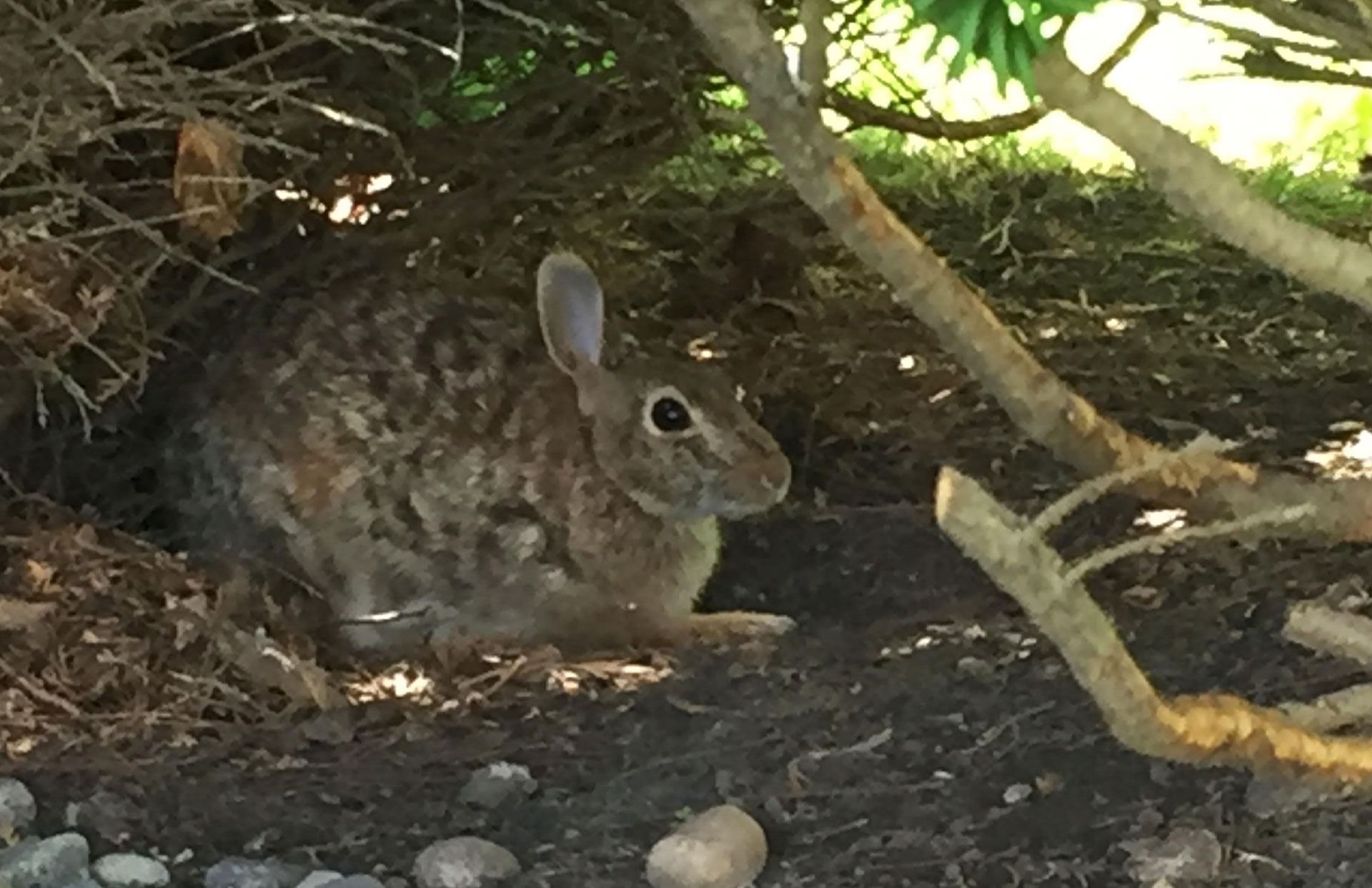“We like to use adorable terms when we’re doing things for bunnies,” said then-HRS board member Dana M. Krempels, PhD, presenting at the House Rabbit Society Educators’ Conference in St. Louis (2014). Indeed! Language is a readily available, no-cost tool we use to establish intimacy both within a household of pawrents and furkids and among people with shared values and experiences like those in HRS.
In my house, our dialect is filled with adorable vocabulary and phrases that fellow bunny parents could both understand and appreciate: Bunny 500, bonks, fresh Timmies, melting into butt rubs. But lacking context, even Dr. Krempels would be challenged to fully decipher our talk of donuts, church, access denied, and smoothing. These are said by my partner or me to one another with a knowing look and a wink in our voices.
As a House Rabbit Society Educator equally fascinated by animal behavior (including humans’) and linguistics, I constantly notice how our community talks and writes about rabbits. Below I share words that will be new to many readers. They are beautiful, precise, and able to fill gaps in labeling behaviors of rabbits both in our homes and in the urban wild, and I invite you to try using them. Maybe they will become part of your lexicon for lagomorphs. And all those cute, coded things you say that only you and your bunnies understand? Keep those, too.

Pandiculation (pan-dik-you-LAY-shun)
Chances are, you do this every day before rising from bed or getting up from a too-long-sat-upon desk chair. You likely see your rabbit do this throughout the day too.
What it means: A stretching and stiffening especially of the trunk and extremities as when fatigued and drowsy or after waking from sleep*; systematic, coordinated stretching in such a way as to extend vigorously and stiffen extremities and trunk1
Where it’s from: A verb from the early 1600s derived from the Latin pandiculari: to stretch oneself†
What it looks like: Calling it simply “stretching” belies the vicarious deliciousness enjoyed when watching a rabbit pandiculate. At the end of a snooze, your bunny will slowly rise up as if being lifted vertically by an outside force. Starting from the rear, her back will both arch and lengthen, front limbs reaching and reaching stepwise forward to extend further and further, back feet flipped over the toes and extended with hocks to the sky, her body simultaneously tensed and pulled, and then she will yawn a most contented looking yawn, a yawn that seems to say, “OK, I’m ready now. Where’s a snack?” Her body will return to bunnyshape, and she’ll hop about her business. Pandiculation is different from a routine stretch because it follows a constrict-release/stretch-relax sequence of the muscles. Estimates say animals may pandiculate as many as 40 times per day!2
Used in a sentence: Harley snoozes like a loaf of dense fruitcake, but when she pandiculates she becomes a two-foot-long baguette.
Stot (rhymes with “hot”)
We all know and love binkies; this is something a bit different. No twisting, no wiggles, no 180-degree axis rotation. Just up, down, done.
What it means: To bound with a stiff-legged gait; to bounce*
Where it’s from: A verb from the 1500s‡ and often associated with deer and gazelle behavior
When you’ll see a rabbit do it: Differing theories exist about why animals stot. In vast, open land, a prey animal might stot to gain a predator’s attention, inducing a chase in a sort of “if we’re going to do this, we are doing it on my terms, not yours” scenario. This is called pursuit invitation.3 I have not observed any domestic buns doing this; our bonded pair are more likely to be chasing me in effort to prey upon the apple I am eating. Another reason animals stot is theorized to be pursuit avoidance.3 The stot could serve to signal fellows, “Hey, let’s all group together. Safety in numbers!” Again, I doubt this is what my buns are doing. Though I swear they do conspire against me (why does she control all the apples? and bananas?! we must take action!), when I see a stot, it is usually near me, not in avoidance of me. In this case, the stot may function to get a moment of additional height and see better, or it may be a play behavior.
Used in a sentence: Cocoa ran once around my feet and stotted a foot off the ground as I opened the bag of bunny cookies.

Thigmotaxis (thig-moh-TAX-iss)
Many animals (including humans) feel more secure when in contact with a stable object or a defined boundary.
What it means: A taxis (orientational movement) in which contact especially with a solid body is the directive factor, also known as wall-hugging*
Where it’s from: Circa 1900, derived from the Greek taxis: arrangement + the Greek thigma: touch†
When you’ll see it: As a rabbit explores an unfamiliar and open space, he tends to stay near a wall or along fencing. This is exactly what our first rabbit did when brought into the adoption room at the shelter to meet us. You might also notice your bunny prefers to rest at the border of two differently patterned rugs in your home. The break in visual field serves as an orientation landmark in your bunny’s mental map of escape routes. Whether it’s you at a party or your new bun at home, thigmotaxis increases with anxiety and decreases with familiarity of the environment.4
Used in a sentence: When we brought Tulip home, she showed a lot of thigmotactic behavior initially, but then started exploring and chinning all the toys around her new room.

Meuse (rhymes with “shoes”)
This is one I really hope catches on in HRS circles. It is such a practical yet lovely word that—if adopted by modern bunny-people—can be cemented to images of contented, resting rabbits . . . and not the hunt.
What it means: The form or lair of a hare; alternate usage: an artificial tunnel made to bring rabbits into a trap‡
Where it’s from: Derived from the French mucer: to hide, conceal oneself; alternately spelled “mews” circa 1890‡ (Regional to Britain, it was a frequent term in 16th and 17th century proverbial sayings such as “every hare has its meuse.”‡ Now considered obsolete.)
Where you’ll see it: Outdoors, you may find a rabbit meuse under vegetative cover. In our yard, a mature Eastern Cottontail (formal term) has a meuse each summer below our large yew. This past year, a recently weaned cottie (adorable term) made a meuse underneath the lavender that grows against the side of the shed and allowed for thigmotaxis. Indoors, our male rabbit has made a comfy meuse on top of a marshmallowy cushion along the back of our couch. Much like his cousins in the yard, he digs at the surface and then pushes the spot smooth with his front feet, making a soft dent to fit his pre-pandiculating shape.
Used in a paragraph: “When an animal, a rabbit, say, beds down in a protecting fencerow, the weight and warmth of his curled body leaves a mirroring mark upon the ground. The grasses often appear to have been woven into a birdlike nest, and perhaps were indeed caught and pulled around by the delicate claws as he turned in a circle before subsiding into rest. This soft bowl in the grasses, this body-formed evidence of hare, has a name, an obsolete but beautiful word: meuse.”
—Sally Mann, American photographer5
References
* Merriam-Webster Dictionary, www.merriam-webster.com
† Online Etymology Dictionary, www.etymonline.com
‡ Oxford English Dictionary subscription database
1 A.F. Fraser, “Pandiculation: The Comparative Phenomenon of Systematic Stretching,” Applied Animal Behaviour Science 23, no. 3 (June 1989): 263-268.
2 Shoba Narayan, “Pandiculation Is No Gobbledygook. mint, September 29, 2016, https://www.livemint.com/Leisure/MQZFLEXOnj0FXzqAiGvTAO/Arise-and-awake-but-slowly.html.
3 T.M. Caro, “The Functions of Stotting: A Review of the Hypotheses,” Animal Behaviour 34, no. 3 (June 1986): 649-662.
4 Ann Sussman and Justin B. Hollander, “Edges Matter: Thigmotaxis (the ‘Wall-Hugging’ Trait),” in Cognitive Architecture (Oxfordshire: Routledge Publishing, 2014), 10-55.5 Sally Mann, “Prologue: The Meuse,” in Hold Still: A Memoir with Photographs (New York: Little, Brown and Company, 2015), xiv.
Reviewed by HRS staff
Author: Amy A. FreePhoto Credit: Amy A. Free
Journal Issue: House Rabbit Journal, Summer 2021




